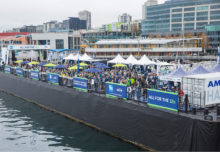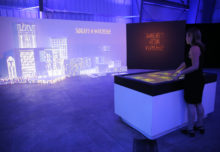Among events to take place in reopened states in Q2 was the 16th annual Oklahoma City Farm Show, June 18-20. Rescheduled from April, the indoor-outdoor show with its 150,000 square feet of agricultural and ranching exhibits allows attendees to get up close and personal with the latest machinery, equipment, technology and services. Among exhibiting brands was Can-Am, part of the BRP (Bombardier Recreational Products) company, which manufactures ATV and side-by-side style vehicles used by farmers and ranchers for both work and leisure.
Can-Am’s bright, all-new exhibit marked the company’s first in-person event since COVID-19 shutdowns in the spring, and it involved the implementation of a nearly 20-page safety and protocol document developed from CDC guidelines. Despite the 15-percent dip in attendance of the farm show year-over-year (less of a dip than what was initially estimated taking into account consumer comfort levels), the brand experienced a four-percent increase in leads.
 More on Trade Shows in the COVID-19 Era:
More on Trade Shows in the COVID-19 Era:
- CES is Moving Forward with a Physical Event in 2021
- How Four Brands Transformed Trade Show Environments into Virtual Experiences
A new strategy this year for Can-Am involved shifting its messaging from work to lifestyle marketing. The exhibit design featured Can-Am’s signature black, white and yellow colors throughout. There were vehicles for attendees to check out, a sweepstakes they could enter to win prize packages and displays and content that demonstrated the duality and flexibility of the products—for playing hard, and working hard, on the land.
Activating in a pandemic-impacted world requires planning, flexibility and space. We drill down five insights from Can-Am’s agency, Match Marketing Group of Boulder, CO, on what it took to stand it up.
FLEXIBILITY
The original design of the exhibit needed to be reworked to create a more spacious footprint to allow for social distancing and fewer surfaces to clean. In other words, simpler was better. In the case of Can-Am, the team created extra space around the sweepstakes entry tablets and added more open areas to enter the footprint from the show floor aisles.
SIGNAGE
The team increased signage on the ground and on table tops with instructions advising attendees to remain six feet apart. Circular markers on the floor throughout the exhibit gave attendees an idea of where to stand to create space. The brand colors just so happen to be black, yellow and white—the colors for “caution”—which made the signage stand out and enhanced the branding element of the design as well.
STAFF TRAINING
In addition to training staff on product details, the Can-Am team trained staff to rethink how they engage booth attendees. This included making sure staff were constantly aware of how close they were getting to people while still being personable and approachable, speaking louder through masks, and taking more breaks, because wearing PPE and social distancing requires extra physical and mental energy. All staff took a quiz each day on symptoms and where they traveled in addition to undergoing temperature checks on-site.
HEALTH PROTOCOLS
Cleaning protocols ran the gamut from wiping down surfaces to supplying styluses for the tablets to enter the sweepstakes. Staff placed a container of freshly cleaned styluses on one side and a container for used styluses on the other. The styluses were routinely disinfected throughout the day. Hand sanitizer was available within the exhibit, the staff wore yellow, branded masks, and there was a printing press for attendees to customize yellow bandanas for swag.
COVID CLIMATE
Depending on the market a brand is exhibiting in masks may not be mandated, so it’s important for teams to establish protocols surrounding personal comfort levels and how to interact with attendees. Brands and partners also have to manage expectations and their goals and adjust metrics accordingly market-to-market based on anticipated attendance.






